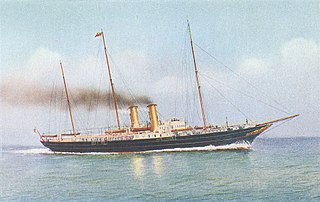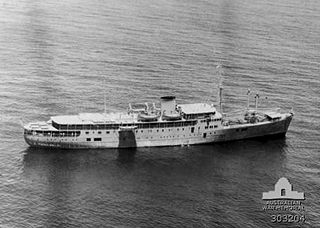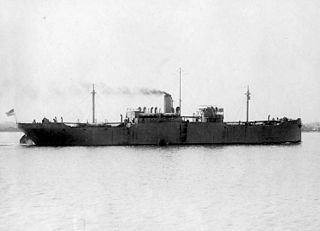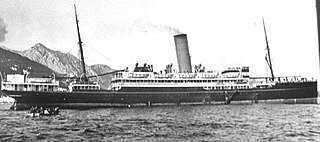 W
WHMY Alexandra was a steamship built as a British royal yacht, completed in 1908. Normally transporting Britain's royal family to European ports, Alexandra served as a hospital ship during the First World War. After 17 years of British service, she was sold to Norwegian commercial interests in 1925. Renamed Prins Olav, she was first used as a luxury cruise ship on trips to the North Cape, she was converted to take more passengers and cargo. In 1937 she began sailing as a Hurtigruten passenger/cargo ship along the coast of Norway. After being requisitioned by the Norwegian government following the 9 April 1940 German invasion of Norway, she transported troops for the Norwegian war effort. Prins Olav was sunk by German bombers on 9 June 1940, while attempting to escape to the United Kingdom as the Norwegian Campaign was coming to an end.
 W
WTSS Arahura was a twin screw steam passenger/cargo ship built for the Union Steam Ship Company. It was launched on the Clyde on 25 March 1905 and built by William Denny and Brothers Dumbarton at a cost of £52,000. It had a gross weight of 1,607 tons. The ship had accommodation for 201 passengers.
 W
WSS Barøy was a 424-ton steel-hulled steamship delivered from the Trondhjems mekaniske Værksted shipyard in Trondheim in 1929. She had been ordered by the Norwegian shipping company Ofotens Dampskibsselskab for the local route from the port city of Narvik to the smaller towns of Lødingen and Svolvær. After the company suffered ship losses in the 1940 Norwegian Campaign Barøy was put into Hurtigruten service on the Trondheim–Narvik route. She was sunk with heavy loss of life in a British air attack in the early hours of 13 September 1941.
 W
WThe SS Barossa was a 4,239 gross ton cargo ship built by Caledon Shipbuilding & Engineering Company, Dundee for the Adelaide Steamship Company in 1938. She was heavily damaged and sank as a result of damage suffered during the Japanese air raid on Darwin on 19 February 1942. She was salvaged and refloated. Barossa was transferred to Associated Steamships in January 1964, before being sold in May and renamed Cronulla.
 W
WMV Breconshire was a 9,776-gross register ton (GRT) cargo liner built in the late 1930s for the Glen Line. She was taken over by the Royal Navy during World War II as a supply ship and modified to carry fuel oil. The ship participated in many Malta convoys and was sunk by Axis bombers on 27 March 1942.
 W
WMV British Motorist was a 6,891 ton tanker, built by Swan Hunter & Wigham Richardson, Newcastle upon Tyne in 1924 for the British Tanker Company.
 W
WSS Clan Campbell was a British cargo steamship. She was built for Clan Line Steamers Ltd as one of its Cameron-class steamships. She was launched at Greenock in 1937, served in the Second World War and was sunk in the Mediterranean in 1942.
 W
WDon Isidro, delivered in 1939, was the second and larger of two Krupp built motor ships of De La Rama Steamship Company, Iloilo, Philippines in inter-island service. The ship under a time charter by the United States Army as a transport during the Japanese invasion of the Philippines. As defending forces became cut off from supply by the Japanese blockade Don Isidro was one of eight ships, only three of which were successful, known to make an attempt to run the blockade. In that attempt, under her captain Rafael J. Cisneros, Don Isidro became involved in the 19 February Japanese attack on Darwin, Australia where, though not in the port, she was strafed, bombed and left off Bathurst Island burning with all lifeboats destroyed. The captain attempted to make land when she grounded about three miles off Melville Island to which survivors swam. Of the sixty-seven crew and sixteen soldiers aboard eleven of the crew and one soldier were killed or missing. Survivors were rescued by HMAS Warrnambool, taken to Darwin, treated at the hospital and then awaited orders at the 147th Field Artillery camp.
 W
WSS Duilio was the first Italian super ocean liner and one of the largest Italian merchant ships until 1925. She measured 24,281 gross register tons and was the sister of the SS Giulio Cesare, which was launched in 1921. She was constructed for the Italian shipping company “Navigazione Generale Italiana” based in Genoa and constructed by Ansaldo Shipyard owned by Sestri Ponente.
 W
WEmpire Banner was a 6,699 GRT cargo ship which was built by Bartram & Sons Ltd, Sunderland in 1942 for the Ministry of War Transport (MoWT). She was torpedoed by U-77 on 7 February 1943 and sunk later that day by enemy aircraft.
 W
WSS Giulio Cesare was initially a liner of the Navigazione Generale Italiana, which was later operated by the Italian Line. The ship was used to transport first class, second class, and tourist-class passengers.
 W
WSS Mary Luckenbach, was a cargo ship of the United States Navy. She was launched in 1918 and completed the following year by the American International Shipbuilding Corp., Hog Island, Pennsylvania as USS Sac City (ID-3861).
 W
WSS Mauna Loa was a steam-powered cargo ship of Matson Navigation Company that was sunk in the bombing of Darwin in February 1942. She was christened SS West Conob in 1919 and renamed SS Golden Eagle in 1928. At the time of her completion in 1919, the ship was inspected by the United States Navy for possible use as USS West Conob (ID-4033) but was neither taken into the Navy nor ever commissioned.
 W
WUSS Munsomo (ID-1607) was a cargo ship that served in the United States Navy from 1918 to 1919.
 W
WMV Neptuna was a 5,952 ton cargo motor vessel. She was launched as MV Rio Panuco in 1924, renamed MV Neptun in 1931 and finally became MV Neptuna in 1935. She was sunk during the Japanese air raid on Darwin on 19 February 1942, during World War II.
 W
WNorlom was a 6,326 GRT Design 1105 cargo ship that was built in 1919 as Editor by Skinner & Eddy Corporation, Seattle, Washington, United States for the United States Shipping Board (USSB), which became the United States Maritime Commission (USMC) in 1937. In 1941, she was transferred to the British Ministry of War Transport (MoWT) and renamed Empire Dunlin. She was transferred to Norway in 1942 and renamed Norlom. She served until 2 December 1943 when she was bombed and sunk at Bari, Italy.
 W
WPan Kraft was a cargo ship built in 1919 by the Western Pipe and Steel Company of California. She was one of eighteen ships built by the company for the U.S. Shipping Board. After merchant service between the wars, she was to become one of the victims of Great Britain's disastrous Convoy PQ 17 to Russia during World War II.
 W
WSS Rex was an Italian ocean liner launched in 1931. She held the westbound Blue Riband between 1933 and 1935. Originally built for the Navigazione Generale Italiana (NGI) as SS Guglielmo Marconi, its state-ordered merger with the Lloyd Sabaudo line meant that the ship sailed for the newly created Italia Flotta Riunite.
 W
WSS Samuel Huntington was an American liberty ship during World War II. She was the 248th liberty ship authorized by the United States Maritime Commission and was named in honor of Samuel Huntington, a signer of the American Declaration of Independence. SS Samuel Huntington was launched in 1942 and sailed to ports in the Pacific, South America, Africa, and the United Kingdom. She was one of a select group of liberty ships that were outfitted to carry a limited number of either troops or prisoners of war. As part of a convoy to resupply the Allied troops at Anzio, she sank after a successful German bomb attack in January 1944.
 W
WSS Sanct Svithun was a 1,376 ton steel-hulled steamship built by the German shipyard Danziger Werft and delivered to the Norwegian Stavanger-based shipping company Det Stavangerske Dampskibsselskab on 1 July 1927. She sailed the Hurtigruten route along the coast of Norway until she was lost in an air attack on 30 September 1943 during the Second World War.
 W
WSS Thistlegorm was a British armed Merchant Navy ship built in 1940 by Joseph Thompson & Son in Sunderland, England. She was sunk on 6 October 1941 near Ras Muhammad in the Red Sea and is now a well known diving site.
 W
WSS Zealandia, nicknamed "Z", was an historically significant Australian cargo and passenger steamship. She served as a troopship in both World War I and World War II. Zealandia transported the Australian 8th Division. Her crew were the last Allied personnel to see HMAS Sydney, which was lost with all hands in 1941. Zealandia was sunk in the air raids on Darwin of 19 February 1942.